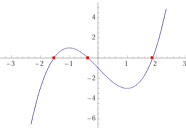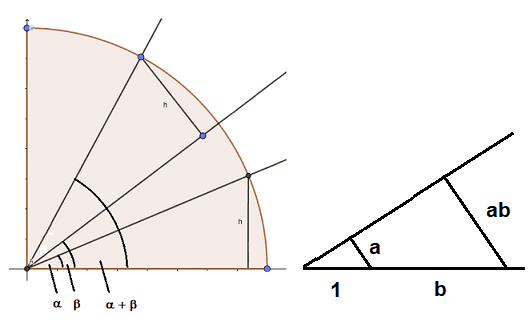Évariste Galois and His Theory

* Oct. 25th, 1811 † May 31st, 1832
… or why squaring the circle is doomed.
Galois died in a duel at the age of twenty. Yet, he gave us what we now call Galois theory. It decides all three ancient classical problems, squaring the circle, doubling the cube, and partitioning angles into three equal parts, all with a compass and ruler alone. Galois theory also tells us that there is no general formula to solve the integer equation
$$
x^5+a_1x^4+a_2x^3+a_3x^2+a_4x+a_5=0
$$
All results are negative. A compass and ruler are not enough to construct a square with the same area as a given circle, to construct a cube that has twice the volume of a given one, to construct the third part of an arbitrary given angle, or to find zeros of arbitrary integer polynomials of degree five or higher. It has a reason that they have been undecided for centuries. They are unsolvable. Since Galois, we know why. The following article explains why without exploring Galois theory in detail, and with a minimum of the theory of Galois groups. The main reason is indeed quickly told.
Table of Contents
Fundamental Theorem of Galois Theory
The intermediate fields of a Galois extension correspond inclusion reversing to the subgroups of its Galois group.
As is so often the case, the devil is in the details, and Galois’s wording has certainly been way more complicated. In fact, the (dead) youngster has been largely ignored, e.g. by Gauß or Jacobi. It was not until Liouville in 1843 he recognized the importance and saw the connection with Cauchy’s theory of permutations and published them in his journal. The details, in this case, are to show that the problems are equivalent to the construction of certain Galois extensions. So the reasons why all these problems are unsolvable are simple. They correspond to a non-existing Galois extension or a non-existing Galois group.
Galois Fields And Galois Groups
What is a Galois extension, and what is a Galois group? Truth is, the names are more frightening than their actual meanings are. Let us consider the easiest example.
$$
x^2+1\in \mathbb{Q}[x]
$$
This equation represents a parabola that doesn’t come closer than ##1## to the ##x##-axis and has therefore no real solutions for ##x^2+1=0.## We need the imaginary unit ##i## to solve the equation. So if we add ##i## to the rational numbers, then we will be able to solve it. We write ##i^2 +1 = 0## and call ## i ## a zero, or root of the rational polynomial ##p(x)=x^2+1.## So
$$
\mathbb{Q}[x]/(p(x))\cong \mathbb{Q}(i) \cong \mathbb{Q}+i\cdot \mathbb{Q}.
$$
The entire trick now is to observe that there is another zero, namely ## -i ##, and a mapping
$$
\iota\, : \,a+ i\cdot b \longmapsto a- i\cdot b
$$
which we know as conjugation has the property to fix rational numbers and map one root to the other. ##\iota## generates a (multiplicatively written), so-called Galois group ##\operatorname{Gal}(\mathbb{Q}(i)/\mathbb{Q}) \cong \mathbb{Z}_2= \langle \iota \,|\,\iota^2=1 \rangle ,## the cyclic group with two elements. The group our computers and light switches are based on. The essential part and reason for the notation are, that the automorphisms in that group do not affect the rational coefficients, and therefore don’t affect the polynomial either. This principle leads us directly to Galois theory because it works for any polynomial. Let’s look at a more complicated polynomial, ##q(x)=x^3-3x-1.## It has no rational root, i.e. it is called irreducible over the rational numbers. But it has three real roots. Let us call the root that is closest to the origin ##\alpha.## Then – note that we do not need to know the numerical value of ##\alpha, ## only that ##\alpha^3=3\alpha +1##

$$
q(x)=(x-\alpha )(x+\alpha^2-2)(x-\alpha^2+\alpha +2)
$$
If we define ##\sigma (\alpha ):=2-\alpha ^2## then
\begin{align*}
\sigma^2(\alpha)&=2-(2-\alpha^2)^2 = -\alpha^4+4\alpha^2-2 = \alpha^2-\alpha -2\\
\sigma^3(\alpha )&= (2-\alpha^2)^2-(2-\alpha^2)-2=\alpha (3\alpha +1)-3\alpha ^2=\alpha
\end{align*}
and ##\operatorname{Gal}(\mathbb{Q}(\alpha )/\mathbb{Q}) \cong \mathbb{Z}_3= \langle \sigma \,|\,\sigma^3=1 \rangle ## is again a cyclic group. If we look at the solutions to ##x^n-1=0## then ##\operatorname{Gal}(\mathbb{Q}(\eta)/\mathbb{Q})\cong \mathbb{Z}_n## for a ##n##-th root of unity, i.e. ##\eta^n=1.## Of course, this is not always the case. If we consider more complicated polynomials, we will get groups of higher order that are not necessarily cyclic.
A Galois extension of the rational numbers is any field extension that arises from adding roots of rational polynomials to the rational numbers no matter how many roots, or how many polynomials. This leads in general to a chain of fields
$$
\mathbb{Q} \subset \mathbb{Q}(\alpha) \subset \mathbb{Q}(\alpha,\beta ) \subset \mathbb{Q}(\alpha,\beta ,\gamma) \subset \ldots
$$
and a corresponding chain of Galois groups
$$
\ldots \supset \underbrace{\operatorname{Gal}(\mathbb{Q}(\alpha,\beta,\gamma)/\mathbb{Q})\supset \operatorname{Gal}(\mathbb{Q}(\alpha,\beta)/\mathbb{Q})}_{{.\,/\,.\;}\cong\;\operatorname{Gal}(\mathbb{Q}(\alpha ,\beta ,\gamma )/\mathbb{Q}(\alpha ,\beta ))}\supset \operatorname{Gal}(\mathbb{Q}(\alpha )/\mathbb{Q})\supset \{1\}
$$
The dimensions of the field extensions are the indexes of the Galois groups.
Geometry and Galois Extensions
We want to describe what can be constructed with a compass and ruler, and nothing else. This has historical reasons because the ancient Greeks posed these three classical problems we mentioned earlier with this restriction. We would get completely different problems if we allowed auxiliary tools, e.g. an Archimedean spiral. So all we start with are a compass, ruler, and a Cartesian coordinate system ##\mathbb{Z}+i\mathbb{Z}## which can be constructed with them. Addition is then vector addition, and subtraction likewise. Multiplication needs the construction
$$
x=a\cdot e^{ i \alpha } \, , \,y=b\cdot e^{ i \beta }\Longrightarrow x\cdot y= (a\cdot b)\cdot e^{{i (\alpha +\beta )}}
$$
of angle addition and real multiplication. The former can be done at the unit circle, the latter with the intercept theorem. The division is simply the other way around.
 The complex numbers here have only been introduced to visualize which constructions that have to be done when we construct rational numbers. The diagonal of squares allows us also the construction of square roots of rational numbers. Hence we have shown the following theorem.
The complex numbers here have only been introduced to visualize which constructions that have to be done when we construct rational numbers. The diagonal of squares allows us also the construction of square roots of rational numbers. Hence we have shown the following theorem.
We can construct a distance with a compass and ruler whenever a solution to a problem is real and can be calculated by rational operations and not necessarily real square roots from given distances …
This sufficient condition is necessary, too. See e.g. van der Waerden [1].
… and vice versa.
This theorem reads in mathematical words
Compass and ruler can construct exactly any Galois extension of the rational numbers that have a degree of a power of two.
Squaring The Circle
Is it possible to construct a square with the same area as a given circle?
We know since 1882, Lindemann [2], now known as Lindemann-Weierstraß theorem, that ##\pi,## the Ludolph number named after the 16th-century Dutch mathematician Ludolph van Ceulen, is transcendental. This means that there is no rational polynomial of any degree such that ##\pi## is a root. Hence there is no Galois extension of the rational numbers that includes ##\pi,## i.e. the distance ##\sqrt{\pi}## is impossible to construct with a compass and ruler.
Doubling The Cube
Is it possible to construct a cube with twice the volume of a given cube?
If a given cube has a volume ##1,## then we are asking for a cube with a volume ##2.## The side length of such a cube would be ##\sqrt[3]{2}.## The rational polynomial that has ##\sqrt[3]{2}## as a root is ##x^3-2.## It has two more irrational roots ##\sqrt[3]{4}\;(-1\pm i\sqrt{3}).## This means that the Galois extension
$$
\mathbb{Q}\subset \mathbb{Q}(\sqrt[3]{2})
$$
is of degree ##3## and therewith no power of ##2.## Doubling the cube (with a compass and ruler) is impossible.
The Angle Trisection
Is it possible to construct a third of an arbitrary given angle?
We can easily construct, e.g., an angle of ##60°## which is a third of ##180°.## It is the slope of the straight ##y=\sqrt{3} \,x,## the angle in an equilateral triangle, or of a hexagon. Thus, the question is not whether we can partition specific angles into their third parts, but rather whether it can be done for any angle. Now, can we construct the angles ##20°## and ##40°,## too? If we draw a circle of radius ##1## then finding the angles is equivalent to finding the heights
\begin{align*}
\sin 60°&=\sin (\pi/3)=\sqrt{3}/2\approx 0.866\\
\sin 40°&=\sin (2\pi/9)\approx 0.643\text{ vs. }2\cdot 0.866 / 3 =0.577\\
\sin 20°&=\sin(\pi/9)\approx 0.342\text{ vs. }0.866 / 3 =0.289
\end{align*}
It is obvious, that we cannot simply cut the height at ##60°## in three parts in order to get a third of ##60°.## ##\sqrt{3}/2## is no problem since it is the root of the quadratic rational polynomial ##x^2-3/4## which belongs to a Galois extension of degree two. But are ##\sin 20°## and ##\sin 40°## even algebraic or are they transcendental? E.g.
$$
\sin 20°=-\dfrac{1}{2} (-1)^{7/18}((-1)^{2/9} – 1)
$$

Fortunately, it doesn’t play a role. Let us consider the formula
$$
\cos(3\alpha )=4\cos^3(\alpha )-3\cos(\alpha )
$$
In our example, we get for ## x:=\cos(20°)##
$$
0.5=\cos(60°)=4\cos^3(20°)-3\cos(20°)=4x^3-3x
$$
The solution to this equation isn’t transcendental, however, it cannot be split into factors over the rational numbers. Its roots involve expressions with the cubic root of something, and cubic roots are of degree three and therefore out of reach for our compass and ruler. ##20°## cannot be constructed.
Polynomials of 5-th Degree or Higher
Solving linear or quadratic integer polynomials is what we learn at school
\begin{align*}
5x + 30 &= 0 \Longrightarrow x=6\\
5x^2+30x+90&=0\Longrightarrow x=-3\pm\sqrt{-9}=-3\pm 3i
\end{align*}
Cubic and quartic equations can be solved by Cardano’s formulas (1545). However, it is unpleasant, doable but unpleasant. E.g. if the polynomial ##p(x)=ax^3+bx^2+cx+d## has exactly one intersection with the ##x##-axis, i.e. exactly one real root, then ##p(x)=0## is solved by
\begin{align*}
x&=-\dfrac{b}{3a}-\dfrac{1}{3a}\sqrt[3]{D+\sqrt{D^2- (b^2-3ac)^3}}-\dfrac{1}{3a}\sqrt[3]{D-\sqrt{D^2- (b^2-3ac)^3}}
\end{align*}
with ##D=b^3-\dfrac{9}{2}abc+\dfrac{27}{2}a^2d.##
The theorem of Abel-Ruffini states that a general polynomial equation of degree five or higher cannot be solved by radicals, means, or root expressions. Of course, there are polynomials of degree five or higher that are solvable, e.g.
$$
0=x^5 – 15 x^4 + 85 x^3 – 225 x^2 + 274 x – 120=(x-1)(x-2)(x-3)(x-4)(x-5),
$$
but, e.g. ##x^5+x^2+1=0,## can only be solved numerically. The first proof of this theorem was published by Ruffini in 1799. However, his proof was patchy and largely ignored. A complete proof was given by Abel in 1824. But a deeper understanding of the matter can only be achieved by Galois theory. Note that we are no longer restricted to Galois extensions of degree ##2^n## since the compass and ruler are irrelevant for solving polynomial equations. Nevertheless, we are restricted to Galois extensions. Every root can be written with algebraic operations over rational numbers and root expressions ##\sqrt[n]{\, . \,}## means, that it is an element of a certain Galois extension of the rational numbers.
We have already observed in two examples ##x^2+1## and ##x^3-3x-1##, that the elements of the Galois groups, which are automorphisms of the Galois fields that keep the base field invariant, map roots to roots like the complex conjugation ##\iota## and ##\sigma ## in our examples did. They hop around on the set of roots, i.e. they generate finite permutation groups. And although we have no restriction on the degree of Galois extensions anymore, we still require the existence of those permutation groups that correspond to Galois extensions if we want to write the roots of rational polynomials with root expressions.
One can show that the Galois groups of such a polynomial equation have to be solvable if the equation is solvable (by root expressions; e.g. [1].) Note the coincidental naming! What is a solvable group? It is a group ##G## that allows a chain of normal subgroups
$$
\{1\} \underbrace{\triangleleft}_{G_1} G_1 \underbrace{\triangleleft}_{G_2/G_1} G_2 \underbrace{\triangleleft}_{G_3/G_2} G_3
\underbrace{\triangleleft}_{G_4/G_3} G_4 \underbrace{\triangleleft}_{\ldots}\ldots\underbrace{\triangleleft}
_{G_n/G_{n-1}} G_n=G
$$
such that all quotient groups ##G_k/G_{k-1} ## are abelian. All alternating groups ##A_n## are simple if ##n\geq 5.## That means they do not have any non-trivial normal subgroups. This reduces the normal chains of the permutation groups to
$$
\{1\}\underbrace{\triangleleft}_{A_n} A_n \underbrace{\triangleleft}_{S_n/A_n\cong \mathbb{Z}_2} S_n
$$
for ##n\geq 5.## However, the alternating groups of higher orders are not abelian anymore
$$
(123)\cdot (345)=(12345) \neq (12453)=(345) \cdot (123)
$$
and therefore not solvable. No solvable permutation groups mean no solvable polynomials and the theorem including the proofreads.
Theorem of Abel-Ruffini
Equations of the form ##x^n+a_1x^{n-1}+\ldots+a_n=0## can generally not be solved if ##n\geq 5.##
Proof: All alternating groups ##A_n## are simple if ##n\geq 5,## and especially not solvable.##\; \square##
Sources
[1] B.L. van der Waerden, Algebra Vol.1, 8-th ed.,
Springer-Verlag, Berlin 1971
https://www.amazon.de/Algebra-German-B-van-Waerden/dp/3642855288/
[2] F. Lindemann, Über die Ludolph’sche Zahl
https://digilib.bbaw.de/digitallibrary/digilib.html
?fn=/silo10/Bibliothek.tiff/10-sitz/1882-2/tif&pn=4
[3] Lindemann-Weierstrass theorem
https://en.wikipedia.org/wiki/Lindemann%E2%80%93Weierstrass_theorem
[4] Gathmann, Kaiserslautern, Satz 8.4
https://www.mathematik.uni-kl.de/~gathmann/class/algebra-2010/algebra-2010-c8.pdf










Leave a Reply
Want to join the discussion?Feel free to contribute!